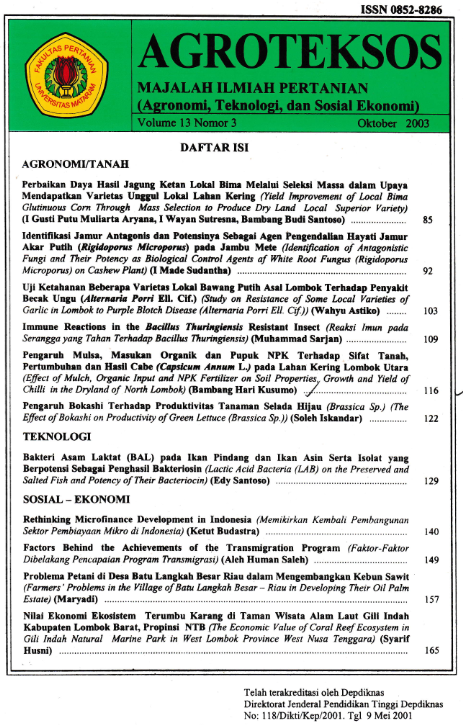7. BAKTERI ASAM LAKTAT (BAL) PADA IKAN PINDANG DAN IKAN ASIN SERTA ISOLAT YANG BERPOTENSI SEBAGAI PENGHASIL BAKTERIOSIN LACTIC ACID BACTERIA (LAB) ON THE PRESERVED AND SALTED FISH AND POTENCY OF THEIR BACTERIOCIN
Main Article Content
Abstract
Tujuan penelitian ini adalah (1) mengetahui karakteristik isolat BAL pada ikan pindang dan ikan asin mulai dari genus sampai spesies; (2) menguji aktivitas anti bakteri patogen dan pembusuk pada isolat BAL tersebut; dan (3) menguji isolat BAL yang berpotensi penghasil bakteriosin. Metode penelitian yang digunakan adalah metoda eksperimental dengan percobaan di Laboratorium. Pada tahap awal dilakukan isolasi BAL dengan metode pengenceran yang dilanjutkan dengan pour plate, sedang identifikasi BAL didasarkan pada karakteristik morfologi, profil protein (SDS-PAGE), uji biokimiawi, uji fisiologi, tipe fermentasi, dan tipe asam laktat. Pada tahap selanjutnya dilakukan uji antagonis terhadap bakteri patogen, pembusuk dan pembentuk histamin dengan metode difusi sumuran, kemudian dilanjutkan dengan skrining BAL penghasil bakteriosin dengan metode difusi agar. Hasil penelitian menunjukkan, bahwa BAL yang paling dominan pada ikan pindang adalah dari Genera Laktobacillus (L. plantarum, L. confusus, dan L. fermentum) ), yang kemudian diikuti genera Streptococcus (S. thermophillus), genera Leuconostoc (Leuc. paramesentroides) dan genera Pediococcus (P. pentosaeceus). BAL yang paling dominan pada ikan asin adalah dari Genera Streptococcus (S. thermophillus) dan genera Laktobacillus (L. plantarum L. confusus, dan L. fermentum) yang kemudian diikuti oleh genera Pediococcus (P. acidophilus). Semua bakteri asam laktat mempunyai aktivitas antibakteri terhadap bakteri patogen dan pembusuk, sedangkan supernatannya hanya mampu menghambat bakteri E. choli, Shigella dan Morganella morganii. BAL jenis Leuconostoc paramesentteroides (ED 6 dan ED 15) ternyata mampu menghambat bakteri indikator yang diujikan, hal ini berarti BAL tersebut mampu menghasilkan antibakteri berupa bakteriosin.
ABSTRACT
The objectives of this research were (1) to know the LAB isolat characteristic at preserved fish and salted fish, genus until species; (2) to test the activity of pahtogen and spoilage bacteria at LAB isolate; (3) to test the LAB isolate which produce the bacteriocin. The research method was experimental method in laboratorium. The first is isolated LAB by using pour plate, with LAB identificated accourding to characterisitic of morphology, protein (SDS-PAGE), biochemical test, physiological test, fermentation type and type of lactic acid. Then conduct the antagonist test of pahtogen bacteri, spoilage and produce histamin with difussion method, and continuied with screning of LAB bacteriosin by using agar difussion method. The result of this research were to isolate and identify (LAB) of preserved fish, examine anti microbial activity to pathogen and spoilage bacteria as well as their bacteriosin potencies. The result of this research showed that LAB the most dominant of preserved fish were genera Streptococcus (S. thermophillus), and followed by genera Lactobacillus (L. plantarum, L. confunsus and L. fermentum), genera Leuconostoc (Leuc. paramesenteroides) and genera Pediococcus (P. pentosaecius). LAB the most dominant of salt fish were genera Streptococcus (S. thermophillus) and genera Lactobacillus (L. plantarum, L. confunsus, and L. fermentum) and followed by genera Pediococcus (P. acidophillus). All LAB had anti bacteria activity to pathogen and spoilage bacteria, and whreas their supernatant was only available to resist bacteria E. coli, Shigella and Morganella morganii. LAB Leuc. paramesenteroides (ED 6 and ED 15) type in fact is available to resist bacteriaforexamined indicator. Therefore, this LAB could produce antibacterial including forming in bacteriocin.

